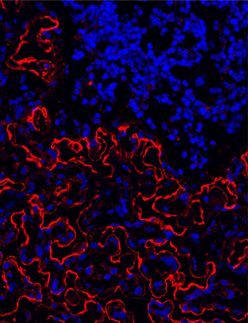White blood cells found to play key role in controlling red blood cell levels
Researchers at Albert Einstein College of Medicine of Yeshiva University and the Icahn School of Medicine at Mount Sinai have found that macrophages – white blood cells that play a key role in the immune response – also help to both produce and eliminate the body's red blood cells (RBCs). The findings could lead to novel therapies for diseases or conditions in which the red blood cell production is thrown out of balance. The study, conducted in mice, is published in the online edition of the journal Nature Medicine.
"Our findings offer intriguing new insights into how the body maintains a healthy balance of red blood cells," said study leader Paul Frenette, M.D., professor of medicine and of cell biology and director of the Ruth L. and David S. Gottesman Institute for Stem Cell and Regenerative Medicine Research at Einstein. "We've shown that macrophages in the bone marrow and the spleen nurture the production of new red blood cells at the same time that they clear aging red blood cells from the circulation. This understanding may ultimately help us to devise new therapies for conditions that lead to abnormal RBC counts, such as hemolytic anemia, polycythemia vera, and acute blood loss, plus aid recovery from chemotherapy and bone marrow transplantation." Einstein has filed a joint patent application with Mount Sinai related to this research, which is currently available for licensing and further commercialization.
Previous studies, all done in the laboratory, had suggested that macrophages in the bone marrow act as nurse cells for erythroblasts, which are RBC precursors. But just how these "erythroblastic islands" (macrophages surrounded by erythroblasts) function in living animals was unclear.
A few years ago, Andrew Chow, a Mount Sinai M.D./Ph.D. student in the laboratories of Drs. Frenette, and Miriam Merad, M.D., Ph.D., professor of oncological sciences and immunology at Mount Sinai found that bone marrow macrophages express a cell surface molecule called sialoadhesin, or CD169 – a target that could be used for selectively eliminating macrophages from bone marrow. Doing so would help pinpoint the role of macrophages in erythroblastic islands in vivo.
That's what Drs. Frenette and Merad did in the current study involving mice. They found that selectively eliminating CD169-positive macrophages in mice reduces the number of bone marrow erythroblasts – evidence that these macrophages are indeed vital for the survival of erythroblasts, which develop into RBCs.
"What was surprising is that we couldn't see any significant anemia afterward," said Dr. Frenette. The researchers then analyzed the lifespan of the red blood cells and found that they were circulating for a longer time than usual.
"After we depleted the macrophages in the bone marrow, we discovered that we had also depleted CD169-positive macrophages present in the spleen and liver. It turns out that the macrophages in these two organs are quite important in removing old red blood cells from the peripheral circulation. Taken together, the findings show that these macrophages have a dual role, both producing and clearing red blood cells," he said.
The researchers also examined the role of macrophages in polycythemia vera, a genetic disease in which the bone marrow produces too many RBCs, typically leading to breathing difficulties, dizziness, excessive blood clotting and other symptoms. Using a mouse model of polycythemia vera, they found that depleting CD169-positive macrophages in bone marrow normalizes the RBC count. "This points to a new way to control polycythemia vera," said Dr. Frenette. "Right now, the standard of care is phlebotomy [periodic blood removal], which is cumbersome."



















































